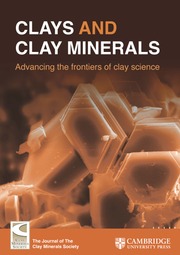No CrossRef data available.
Article contents
Effect of layer bending on montmorillonite hydration and structure from molecular simulation
Published online by Cambridge University Press: 20 November 2024
Abstract
Conceptual models of smectite hydration include planar (flat) clay layers that undergo stepwise expansion as successive monolayers of water molecules fill the interlayer regions. However, X-ray diffraction (XRD) studies indicate the presence of interstratified hydration states, suggesting non-uniform interlayer hydration in smectites. Additionally, recent theoretical studies have shown that clay layers can adopt bent configurations over nanometer-scale lateral dimensions with minimal effect on mechanical properties. Therefore, in this study we used molecular simulations to evaluate structural properties and water adsorption isotherms for montmorillonite models composed of bent clay layers in mixed hydration states. Results are compared with models consisting of planar clay layers with interstratified hydration states (e.g. 1W–2W). The small degree of bending in these models (up to 1.5 Å of vertical displacement over a 1.3 nm lateral dimension) had little or no effect on bond lengths and angle distributions within the clay layers. Except for models that included dry states, porosities and simulated water adsorption isotherms were nearly identical for bent or flat clay layers with the same averaged layer spacing. Similar agreement was seen with Na- and Ca-exchanged clays. While the small bent models did not retain their configurations during unconstrained molecular dynamics simulation with flexible clay layers, we show that bent structures are stable at much larger length scales by simulating a 41.6×7.1 nm2 system that included dehydrated and hydrated regions in the same interlayer.
Keywords
- Type
- Original Paper
- Information
- Copyright
- © The Author(s), 2024. Published by Cambridge University Press on behalf of The Clay Minerals Society



